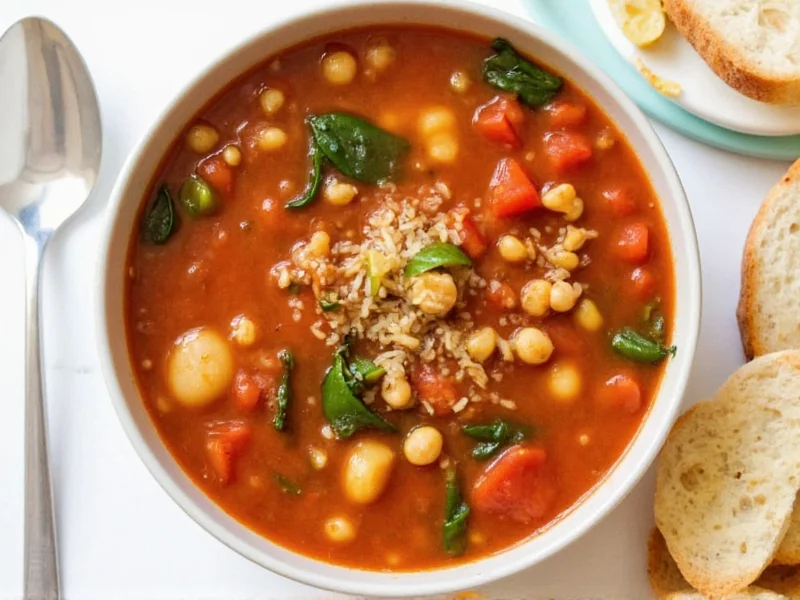The Timeless Tradition of Minestrone Soup
Minestrone soup represents one of Italy's most enduring culinary traditions, with roots tracing back to ancient Roman minestra—meaning “to serve.” Originally a humble peasant dish designed to use available seasonal vegetables, minestrone evolved into a beloved national treasure. Unlike many soups with fixed recipes, authentic minestrone changes with the seasons: spring brings fresh peas and asparagus, summer features ripe tomatoes and zucchini, while winter versions incorporate hearty root vegetables and cabbage.
Essential Ingredients for Authentic Minestrone
The magic of minestrone lies in its flexible framework rather than rigid ingredient requirements. However, certain elements remain consistent across regional variations. The soffritto—a flavor base of onions, carrots, and celery—forms the aromatic foundation. Quality extra-virgin olive oil, tomatoes (fresh in season or canned off-season), and leafy greens like escarole or spinach provide essential depth. Beans add protein and texture, while pasta or rice transforms it from soup to satisfying meal.
| Ingredient | Quantity | Preparation Notes |
|---|---|---|
| Extra-virgin olive oil | 3 tablespoons | Use high-quality oil for finishing |
| Yellow onion, finely diced | 1 medium | Yellow onions provide best flavor balance |
| Carrots, diced | 2 medium | ¼-inch dice ensures even cooking |
| Celery stalks, diced | 2 stalks | Include leafy tops for extra flavor |
| Garlic cloves, minced | 3 | Add after vegetables soften to prevent burning |
| Canned whole tomatoes | 28-ounce can | San Marzano preferred for authentic flavor |
| Homemade vegetable broth | 6 cups | Low-sodium preferred for better control |
| Cannellini beans, drained | 15-ounce can | Or 1½ cups cooked dried beans |
| Zucchini, diced | 1 medium | Add during summer months for seasonal authenticity |
| Green beans, trimmed | 1 cup | Fresh preferred, cut into 1-inch pieces |
| Kale or escarole, chopped | 2 cups packed | Add during last 10 minutes of cooking |
| Ditalini pasta | ½ cup | Or small pasta of choice; cook separately for meal prep |
| Fresh basil | ¼ cup, chopped | Add just before serving for bright flavor |
| Parmesan rind (optional) | 1 piece | Add while simmering for umami depth |
Step-by-Step Preparation Guide
Creating authentic minestrone requires attention to technique rather than precision. Begin by heating olive oil in a heavy-bottomed pot over medium heat. Add the soffritto (onion, carrots, celery) and cook gently for 8-10 minutes until softened but not browned—this builds flavor without bitterness. Stir in garlic during the last minute until fragrant.
Add tomatoes with their juices, breaking them up with a spoon. Simmer for 5 minutes to concentrate flavors before adding vegetable broth, beans, and any hard vegetables like potatoes or winter squash. Bring to a gentle boil, then reduce heat to maintain a steady simmer.
Cook uncovered for 20 minutes to allow flavors to meld, then add medium-firm vegetables like green beans and zucchini. Continue simmering another 15 minutes before incorporating leafy greens and pasta. For best results with meal prep, cook pasta separately and add to individual servings to prevent mushiness.
Professional Cooking Techniques for Superior Minestrone
Mastering minestrone involves understanding several key techniques. First, never rush the soffritto—cooking these aromatics slowly develops complex flavors. Second, layer vegetables by cooking time: hard vegetables first, delicate greens last. Third, maintain a gentle simmer rather than vigorous boil to preserve vegetable integrity.
For restaurant-quality depth, consider making your own vegetable broth using mushroom stems, onion skins, and herb scraps. If using canned broth, enhance it with a Parmesan rind during cooking (remove before serving). The acid balance matters too—a splash of good red wine vinegar or lemon juice at the end brightens flavors that may have mellowed during cooking.
Seasonal Variations and Dietary Adaptations
Traditional minestrone changes with the seasons, and your recipe should too. Spring minestrone features fresh peas, asparagus, and fava beans. Summer versions showcase ripe tomatoes, zucchini, and fresh herbs. Autumn brings cabbage, potatoes, and beans, while winter minestrone relies on stored root vegetables and hearty greens.
For gluten-free minestrone soup preparation, simply omit pasta or substitute with small-cut gluten-free pasta cooked separately. Vegan minestrone requires ensuring broth contains no animal products—many commercial vegetable broths contain honey or dairy derivatives. To boost protein content in vegetarian minestrone soup, increase bean varieties or add a handful of cooked lentils.
Serving and Storage Recommendations
Minestrone tastes best when allowed to rest for several hours or overnight, as flavors continue developing. Serve hot with a drizzle of premium olive oil and freshly grated Parmesan cheese. For traditional presentation, offer crusty bread on the side rather than mixing it into the soup.
Properly stored in airtight containers, minestrone maintains quality for 4-5 days in the refrigerator. Freeze portions for up to 3 months—though pasta may become slightly soft upon thawing, which is why many chefs recommend cooking pasta separately when planning to freeze. Reheat gently on the stove, adding a splash of water or broth if needed to restore ideal consistency.
Troubleshooting Common Minestrone Challenges
Thin minestrone often results from insufficient vegetable content or too much broth. Fix this by simmering uncovered to reduce liquid or adding more diced vegetables. If your soup tastes flat, balance with acid (lemon juice or vinegar), salt, or a Parmesan rind. For overly acidic minestrone, a pinch of sugar or baking soda can neutralize excess tomato tartness.
When minestrone becomes too thick after refrigeration, simply thin with additional broth or water while reheating. To prevent pasta from absorbing too much liquid in leftovers, follow the Italian tradition of cooking pasta separately and adding it to individual bowls when serving.











 浙公网安备
33010002000092号
浙公网安备
33010002000092号 浙B2-20120091-4
浙B2-20120091-4